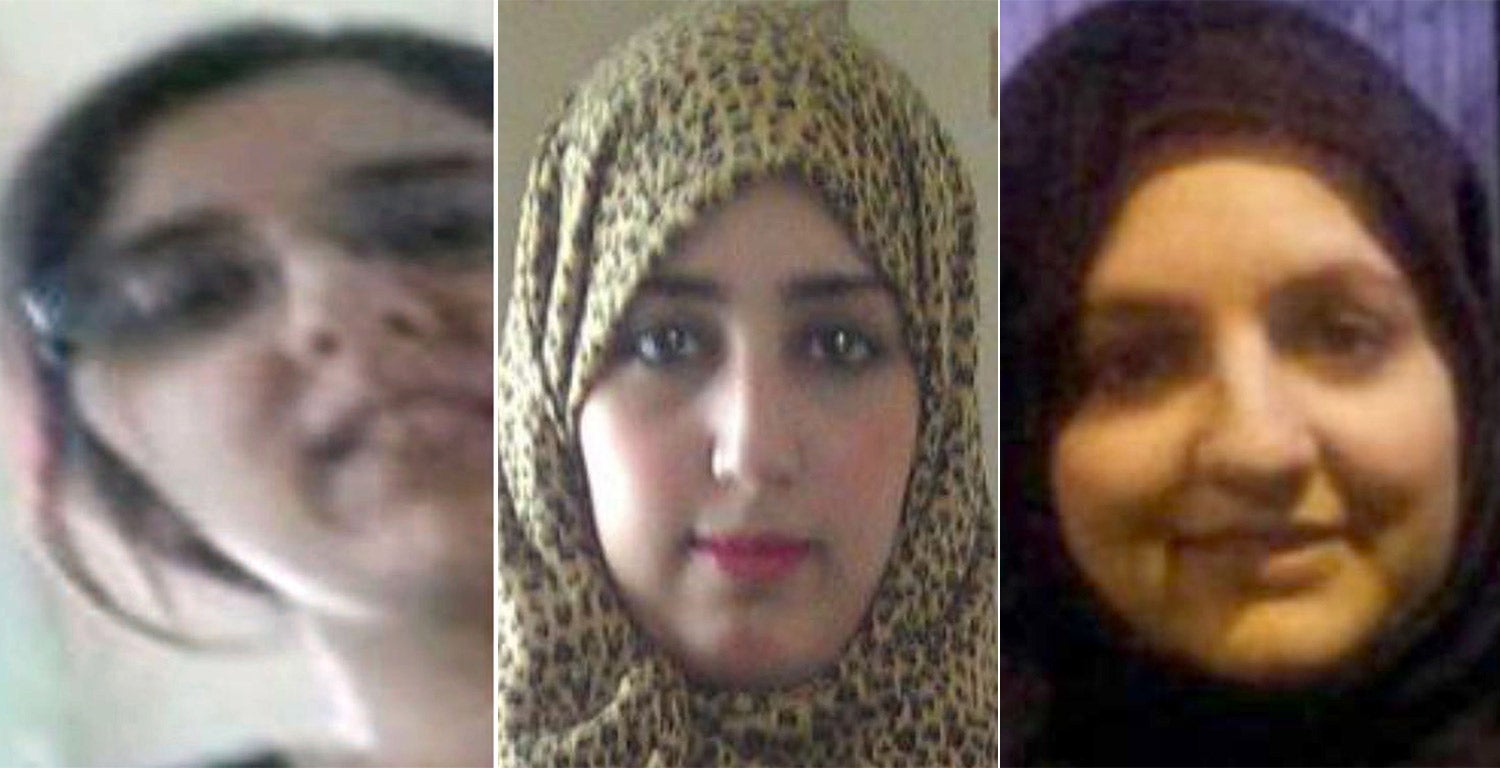The Britons who went to join Isis: Where are they now?
More than 200 British citizens still unaccounted for
Your support helps us to tell the story
From reproductive rights to climate change to Big Tech, The Independent is on the ground when the story is developing. Whether it's investigating the financials of Elon Musk's pro-Trump PAC or producing our latest documentary, 'The A Word', which shines a light on the American women fighting for reproductive rights, we know how important it is to parse out the facts from the messaging.
At such a critical moment in US history, we need reporters on the ground. Your donation allows us to keep sending journalists to speak to both sides of the story.
The Independent is trusted by Americans across the entire political spectrum. And unlike many other quality news outlets, we choose not to lock Americans out of our reporting and analysis with paywalls. We believe quality journalism should be available to everyone, paid for by those who can afford it.
Your support makes all the difference.Some 900 British citizens have left the country to join Isis over the past seven years.
The chaos of the Syrian civil war opened the way for the terror group to transform from an underground insurgency and expand, eventually leading to the declaration of an “Islamic State” across Iraq and Syria.
The promise of a life under its strict interpretation of Islam acted as a lightning rod for British jihadists and sympathisers. Some went to fight for the group, others went to live as citizens of the self-declared state.
That exodus sparked a security crisis for the British intelligence services, who feared those citizens may one day return to carry out attacks.
Many of them disappeared from view for years, living their lives in the extremist group’s captured lands. But as the caliphate crumbles, they are beginning to emerge again.
Shamima Begum, one of three teenage girls who left their lives in Bethnal Green in London in 2015, turned up at a displacement camp in northern Syria this week, declaring her wish to return to the UK.
More than 200 those who left are still unaccounted for. There are thought to be around 20 British women and children currently in displacement camps in northern Syria, and potentially more than a dozen still yet to emerge from the last pocket of Isis-held territory.
Kadiza Sultana, Amira Abase and Shamima Begum

The three friends, aged 15 and 16 at the time, fled to Syria via Turkey after disappearing during the Easter holidays in 2015.
The schoolgirls, who attended Bethnal Green Academy, are believed to have been radicalised online and encouraged to join Isis. They had been questioned by police in December 2014 after another girl from the school travelled to Syria but were not found to be at risk.
Kadiza’s family said she became disillusioned after her arrival in Raqqa and the death of her husband, an American Isis fighter of Somali descent. Her parents were told she was killed in a Russian air strike on the city in May.
Little had been heard from Begum until she appeared in al-Hol camp, northern Syria, this week. Now 19, she said in an interview with The Times that she wanted to come home.
“I don’t regret coming here,” she said. ”I just want to come home to have my child. I’ll do anything required just to be able to come home and live quietly with my child.”
She said she had heard that Abase, one of the two girls she fled to Syria with, might still be alive.
Mohammed Emwazi, aka ‘Jihadi John’

Mohammed Emwazi was a computer programmer who moved to London aged six from Kuwait and later studied at the University of Westminster. Emwazi was on the radar of intelligence agencies, but he managed to slip through the net and travel to Syria in 2013.
While there he was part of a group an execution squad made up of four British Isis members who were dubbed “The Beatles” for their British accents.
He became known to the world after appearing in execution videos of western hostages, including American journalist James Foley, UK aid worker David Haines and taxi driver Alan Henning.
He was killed in a drone strike in November 2015.
Alexanda Amon Kotey and El Shafee Elsheikh, aka ‘The Beatles’

Alexanda Amon Kotey and El Shafee Elsheikh were part of the notorious “Beatles” execution squad, along with Emwazi. The group is thought to be responsible for the beheading of more than 27 hostages and the torture of many others.
Elsheikh, the son of Sudanese refugees, was a car mechanic before he left for Syria in 2012. Kotey was born in the UK to a Ghanaian father and a Greek Cypriot mother.
The pair were arrested by the Syrian Democratic Forces (SDF) in January 2018 while trying to flee Isis territory, and have been in the group’s custody ever since. The UK has reportedly stripped them of their citizenship, and plans to send them to the US to face prosecution.
In interviews since their capture, the pair deny they played a part in executions.
Aqsa Mahmood

The 21-year-old travelled to Syria from her family home in Glasgow in November 2013 and became prolific for spreading Isis propaganda online.
The former university student was known for her blog and social media accounts under the name Umm Layth – which has since been removed – where she praised terror attacks in Tunisia and France.
She frequently called for other young British women to travel to the so-called Islamic State and was suspected of helping the Bethnal Green trio reach Syria.
Mahmood married an Isis fighter and reportedly rose up the group’s ranks to become a leading figure in the al-Khansaa brigade, the feared all-female force tasked with enforcing the group’s interpretation of sharia law with women and children.
Punishments have included arrests and beatings for women going outside without a male chaperone, lashes for wearing form-fitting abayas and floggings for “not being meek enough”.
In 2017, she was among 150 suspected jihadists who were stripped of their citizenship to stop them returning to the UK.
Her whereabouts are currently unknown.
Siddhartha Dhar, aka ‘Jihadi Sid’

Siddhartha Dhar, a former bouncy castle salesman from Walthamstow, was on bail for terrorism offences in the UK when he fled to Syria to join Isis.
The British-Indian Muslim convert was arrested alongside Anjem Choudary in 2014 on suspicion of belonging to the now-defunct terrorist organisation Al-Muhajiroun. He was even interviewed for a Channel 4 documentary titled The Jihadis Next Door. Still, he managed to skip bail and travel to Syria.
While there, he appeared in a gruesome 2016 video which showed the execution of several prisoners Isis accused of spying for the UK. The US State Deparment put him on a list of global terrorists in 2018, saying that he had replaced Jihadi John in his role as chief executioner.
His whereabouts are unknown.
Grace ‘Khadijah’ Dare

The 24-year-old was one of the first British women to travel out to Syria, leaving in 2012 to join the jihadist cause with her baby son Isa.
Dare, who was brought up in south London as a Christian but converted to Islam in her teens, attended the same mosque as the men who murdered Lee Rigby in Woolwich. She fled London for Syria in 2012 and resurfaced the following year in a Channel 4 documentary on British women joining the “jihad”.
Giving her name as Maryam, she was filmed alongside her Swedish husband, a militant known as Abu Bakr who has since been killed.
The couple were reportedly expecting their first child and Dare vowed to remain in Syria to raise her children.
She became prolific on Twitter under the name of Muhajirah fi Sham, which means “immigrant in Syria”, where she celebrated the beheading of James Foley and vowed to be “da 1st UK woman 2 kill a UK or US terorrist!” [sic].
She also gloried in gruesome Isis public executions and called for British Muslims to travel to Syria, as well as posing pictures of Isa with weapons.
Her whereabouts are currently unknown.
Sally Jones

Also known as Umm Hussain al-Britani, the 47-year-old has issued repeated terror threats against the UK, US and Europe and called for supporters to carry out attacks.
She was married to Junaid Hussain, the Isis hacker who was killed in a drone strike last year.
In a Twitter post she claimed she was “proud my husband was killed by the biggest enemy of Allah, may Allah be pleased with him”.
A Muslim convert from Kent, Jones was another prolific propagandist for Isis and published “kill lists” of targets and announced her wish to behead Christians online.
Before fleeing to Syria with her 10-year-old son in 2013, she worked as a perfume saleswoman, previously claiming benefits and playing guitar in a punk band.
She is believed to have been killed by a US airstrike, along with her son, in 2017.
The Dawood sisters

Khadija, 30, Zohra, 33, and Sugra, 34, left Bradford in 2015 with their nine children to join Isis.
After making a pilgrimage to Medina in Saudi Arabia they boarded a flight to Istanbul and crossed into Syria instead of taking their scheduled journey home.
The sisters were reported to be joining their brother Ahmed Dawood, who had been fighting with Isis for more than a year when they left.
They were prevented from travelling out of the UK months earlier after being stopped and questioned attempting to board a flight from Manchester to Jeddah in March 2015.
Their five girls and four boys were aged between three and 15 when they left.
Nothing has been heard from the family since 2015.
Jack Letts, aka ‘Jihadi Jack’

Jack Letts became the first white British man to join Isis when he travelled to Syria in 2014, at just 18.
He had converted to Islam while at Cherwell comprehensive school in Oxford, and was described by his parents as “naive and very religious”.
Letts has repeatedly denied being a member of Isis in interviews he gave from Syria, but he was detained by Kurdish forces while trying to escape from the battle for Raqqa in 2017. Later reports suggested he married an Iraqi woman and had a child.
He remains in the custody of the SDF, and there has been speculation that he may be repatriated to Canada, where he holds dual citizenship.

Join our commenting forum
Join thought-provoking conversations, follow other Independent readers and see their replies
Comments